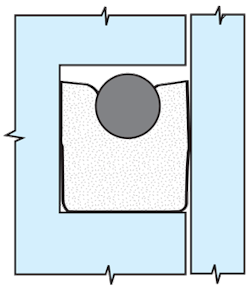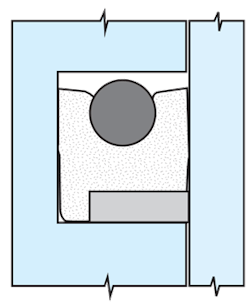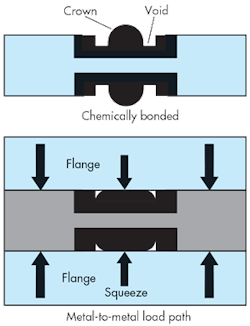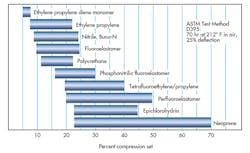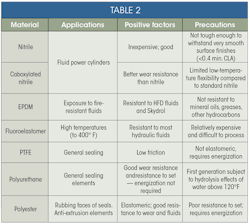Effective high-pressure sealing requires a material or a combination of materials with sufficient tear strength, hardness, and modulus to prevent extrusion through the gap. At pressures of 5000 to 7000 psi, the strongest elastomeric materials in standard seal configurations resist the extrusion without reinforcement. At higher pressures, the elastomeric sealing element must be backed by a higher modulus and harder material. Various, more-or-less standard, backup configurations have demonstrated their effectiveness over many years.
At pressures exceeding 20,000 psi, the extrusion gap must be closed and the elastomeric seal must be protected by a sequence of progressively harder, higher-modulus materials. Properly designed, this progression of materials prevents extrusion, tearing, cutting, or other destructive deformation of the elastomeric seal, and distributes loads more uniformly to the element that bridges the gap.
Designs and Materials
In high-pressure applications, material characteristics, such as high modulus, tear strength, self-lubrication, and abrasion resistance, become increasingly important. Abrasion-resistant and self-lubricating materials should be used at high pressures due to the increasing friction. Materials in this group include:
• Enhanced polyurethane: At the lower end (5000 psi) of the high-pressure continuum, a standard configuration of modified polyurethane energized by a resilient O-ring elastomer (Figure 1) is sufficient. Polyurethane-based materials, such as impregnated with molybdenum disulfide to provide dry lubrication plus good compatibility with lubricating properties of working fluids, can handle application pressures up to 5000 psi without a backup ring.
• Elastalloy co-polymers: Various elastoplastic or elastalloy copolymers (materials with exceptionally high tear strength, abrasion resistance, hardness, and modulus) offer high-pressure performance capabilities. Standard configurations energized by a resilient elastomeric O-ring are suitable for applications up to 7000 psi without a backup ring. However, when used with a modular backup ring, these seals can withstand pressures to 12,000 psi or higher.
• Non-elastomeric materials: Non-elastomers include polyamide resins, such as nylons, modified nylons, and metal backup rings, typically ductile bronze or brass.
An enhanced polyurethane seal with a glass-filled polyamide anti-extrusion ring, (Figure 2) can be used successfully at pressures to 10,000 psi.
These proven designs and materials typify those available to increase the pressure capabilities of elastomeric seals in dynamic applications. Many other materials are good fits for high-pressure applications, too. Often times, the fluid medium, system operating temperatures, cost, or system pressure dictates the choice of seal materials.
However, the potentially higher efficiency of high-pressure systems comes at a slight cost premium. Sealing materials for high pressures are more expensive, and seal designs tend to be more complicated. Higher sealing pressures increase sealing force and friction. Greater friction causes higher wear rates and may require more frequent seal replacement, but frictional force and wear rates typically increase more slowly than pressure.
Hydraulic-system design often seems to focus on dramatic high-pressure applications. For example, the aerospace industry adopted 5000-psi systems for some commercial aircraft, with 5000 being the norm for many military aircraft, such as fighter jets. These high-pressure systems require innovative seal designs in both static and dynamic modes of operation.
This file type includes high resolution graphics and schematics when applicable.
Low-pressure considerations
Almost every hydraulic system, however, will face times when the equipment isn’t operating, and the pressure falls to zero. Or, in some applications, the system’s pressure may never exceed 100 psi. These are typical of the types of operations defined as low pressure; that is, when the confined fluid media exert little or no pressure force on the sealing element to affect or augment a seal.
Within the framework of low-pressure sealing, several primary design considerations affect sealability:
• Seal squeeze
• Compression set
• Sealing force
• Gland surface finish conditions
• Molding flash
Squeeze
In general, a seal component is installed in a groove machined into one of the surfaces to be sealed. When two surfaces come together to form a gland, they squeeze the diametral cross-section of the seal. The mechanical squeezing action deforms the seal cross-section; the degree of deformation obviously is a function of the squeezing force.
In low-pressure applications, the tendency of the squeezed elastomer to maintain its original shape creates a seal. As the elastomer shape becomes deformed in its gland, it exerts a counter force against the mating surfaces equal to the force squeezing it (Figure 3), and hence, provides the available sealing force.
Thus, squeeze is a major low-pressure consideration. The recommended squeeze levels are a function of seal cross-section, the application conditions, and whether the application is dynamic or static. Dynamic compression typically is lower than static compression, due to seal wear and friction considerations. Table 1 summarizes dynamic squeeze levels as defined by MIL-G-5514G — a document that’s a good guide to those parameters. Static data in the table is summarized from common industrial practice.
Compression Set
Compression set reflects the partial memory loss due to the time effect. In hydraulic systems operating over extreme temperature ranges, it’s not uncommon for compression-type seals, such as O-rings, to leak fluid at low pressure due to permanent deformation or the fact that they took a set after being used for a period of time.
The term compression set refers to the permanent deflection remaining in the seal after complete release of a squeezing load while exposed to a particular temperature level. As related to low-pressure sealing, set — the loss of memory — reduces the compressive sealing force.
Compression set is expressed as a fraction of the initial squeeze. Thus, a 0% compression-set value indicates complete recovery from a compressive load, producing the maximum possible compressive sealing force. A 100% set value indicates no recovery or rebound at all. A seal in this condition will no longer provide a sealing force and, therefore, has no ability to act as a low-pressure seal. Figure 4 depicts the range of typical compression set values for various sealing elastomers.
Of course, compression-set properties are a major, but not the only, factor affecting elastomer choice for low-pressure sealing. Compatibility with various hydraulic fluids must be considered as well.
Sealing force
Several factors affect the sealing force, including material hardness, percentage squeeze, and seal cross-section size.
For a certain amount of squeeze, the sealing force is directly related to the hardness or elastic moduli of seal materials for low-pressure applications. The harder the material, the larger the initial sealing force. A seal material’s nonlinear stress-strain curve needs to be described by special material models. For simplicity, linear moduli, such as Young’s modulus and shear modulus, are typically used due to their direct relation to the material hardness. The modulus commonly employed for specification purposes is tensile stress at a specified elongation. For example, modulus at 100% elongation is the tensile stress corresponding to that elongation.
For the most part, a durometer gauge measures hardness— typically using the Shore A scale. The gauge measures the force required to deflect the flat surface of a rubber specimen with a pointed indicator. The A scale ranges from 0 to 100; a 90 Shore A compound would be designated as a hard (or high-viscosity) material and exhibit much higher compressive force than a 60 Shore A compound, which would be classified as soft.
For a specific material, seal compression force of the elastomeric material increases as the percentage deflection of the seal’s diametral cross-section increases. Dynamic squeeze levels typically should be limited to around 12% due to friction and related-wear considerations. Static squeeze levels can be as high as 30%.
It generally is recommended that a minimum of 0.009-in. squeeze be induced on radial seal cross-sections due to compression set considerations. Maximum radial squeeze should be held to 30% because greater squeeze causes assembly difficulties and elastomer deterioration. Compressive sealing load also directly relates to the size of a seal’s cross-section (Figure 5).
Gland Surface Finishes
Two physical characteristics of the seal contact-band areas can affect the transmission efficacy of the available sealing force: parting line projection and flash on the seal, and sealing surface finishes in the gland.
A significant factor in optimizing seal performance concerns the finish on machined surfaces that comes into contact with the seal. Finishes can be defined by different systems, which are often misunderstood and sometimes incorrectly specified in hydraulic design. The American Standard Association provides a set of terms and symbols to define basic surface characteristics, such as profile, roughness, waviness, flaws, and lays.
Roughness, the most commonly specified characteristic, is usually expressed in units of microinches (µin.). Roughness measures the deviation of the surface irregularities from an average plane through the surface. In most cases, geometric average roughness or root mean square (RMS) is the preferred method. RMS measurement is sensitive to occasional peaks and valleys over a given sample length.
As related to low-pressure sealing, the sealing element must penetrate these micro imperfections and irregularities in order to block the passage of the fluid media across the contact band area. It’s generally accepted and recommended that dynamic interfaces should not exceed RMS values of 16 µin. or 0.4 µm. Static interfaces should not exceed 32 µin. or 0.8 µm.
This file type includes high resolution graphics and schematics when applicable.
Seal Materials
The worldwide industries that design equipment incorporating hydraulic and pneumatic technology have changed considerably over the last 40 years — largely in response to the increased expectations of end users. From the standpoint of sealing, these expectations now call for effectively leak-free systems, regardless of the application.
Whereas several decades ago almost all leading OEMs maintained their own acceptability curves that aspiring suppliers had to either equal or surpass, today their approval procedures simply state that zero leakage is the standard. To meet today’s challenges, leading international seal manufacturers have modified existing materials and developed new ones. As a result, today’s materials enable seals can be made in profiles and configurations unheard of a generation ago. Modern hydraulic and pneumatic systems commonly use the seal materials listed in Table 2.
TPU and TPE
Thermoplastic polyurethanes (TPUs) have made the greatest evolutionary strides among materials. Major limitations of the first-generation TPUs — high lip-preload loss (particularly at elevated temperatures, say above 160° F) and poor resistance to water and high humidity — have been overcome. The latest second-generation TPUs can take the system operating range up to 250°F without suffering serious loss of lip preload, and generally don’t require O-ring energization. Hydrolysis resistance in some formulations has advanced to the point where TPU seals are now used in underground-mining cylinders that operate on high-water-based, fire-resistant fluids.
Pneumatic cylinder designers are also reaping the benefits of TPU-sealing advances. Calls for very low friction and ultra-long service life have been accommodated by TPU seals that offer 50% of nitrile’s breakout friction. Furthermore, they last for 12 million cycles in 2-in. bore, 10-in. stroke cylinders with non-lubricated air.
Improvements in modern thermoplastic polyester elastomers (TPEs) now make it possible to chemically engineer TPEs to produce such desirable properties as outstanding wear and fluid resistance. Thus, they have become the first choice in many sealing applications — particularly as piston seals, where, with suitable energization, they deliver extremely efficient performance.
Many TPE seals compete with PTFE elements, where the elastomeric nature of TPE makes them more easy to install and prevents piston drift. An example is in truck-mounted crane outriggers, where the elastomer can bond into the adjacent surface finish. TPEs with their superior wear resistance and tensile strength are ideal for such applications.
In Europe, TPEs are gaining significant traction in specialty sealing applications, particularly in the mining and steel industries. For instance, TPE’s heat and fluid resistance perform well in rolling mills. In port-passing applications, such as phasing cylinders, by exploiting the wear resistance and hardness of TPE, seals can be designed specifically to overcome problems often associated with this type of cylinder design.
The key to success for today’s seal maker lies in combining the latest material technology with innovative profiles to provide the customer with solutions that work.
Future Trends
Environmental issues continue to influence almost all industries, including the hydraulics sector. Europe and the U.S. continue to research and develop so-called environmentally friendly fluids. Vegetable oils, such as rape and sunflower seed, have been tried, but they can cause problems for the system (forming resin above 180° F) as well as for the seals and other components (forming acid in any water present, which can attack elastomers). Other fluid contenders include polyglycols and synthetic esters, but these also present problems—most notably the cost, which is up to ten times that of mineral oil.
New materials and blends will be required to combat the effects of these fluids while still providing the sealing integrity expected by users. Preliminary work indicates that a long road lies ahead if this issue becomes a reality.

